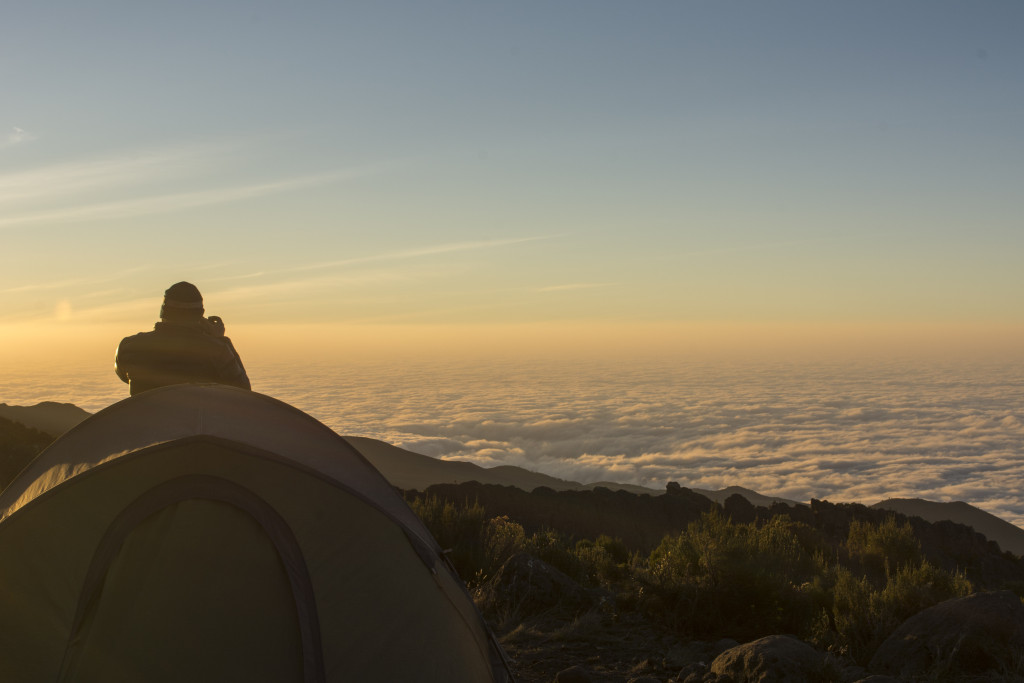
Walking up Kilimanjaro is not cheap. It costs thousands of dollars.
Want to spend all that money and time training only to walk down the mountain with your tail between your legs? That would be embarrassing, and depressing! Yet it happens to thousands of people every year.
So how do you get to the top of Kilimanjaro? Maximise your chances of getting to the summit by doing the following:
1. Go at the Right Time of Year
Tanzania has rainy seasons and a dry seasons.
Walking up a mountain in freezing cold rain is not something I like doing, not even in the UK! At altitude I would hate it!
Less people summit during the rainy season. Spend a few days anywhere walking and camping in miserable weather and you’ll know why. People’s clothes are wet, they never dry, they’re colder as a result, and miserable.
More rain usually means more snow on the summit, which is harder to trudge through. Camping in wet weather is energy sapping, it’s not fun and gets people down. Your doing in one of the hardest physical things you might ever do in your life – you need to keep your spirits up!
We walked up at the end of August and were lucky. We had no rain and it wasn’t windy on the summit either.
The weather’s not guaranteed for any of us. But, do yourself a favour. If you are going to spend thousands trying to climb Kili, go when you’re statistically likely to have good weather at least.
2. Choose the Right Route
Okay, bear with me for this. Please have a look at this map:
The true summit of Kilimanjaro is called Uhuru – this is where you want to get to.
Looking at the map above, you’ll see the Marangu (from the east) and Rongai (from the north) routes make their way to Uhuru Peak via Gilmans Point (small writing), and a base camp called Kibo.
Most of the other routes, from the south and the west, summit via Stella Point (small writing) and a base camp called Barafu Camp.
The walk to Uhuru via Gilmans Point from Kibo, is generally considered to be more difficult than the routes that ascend via Stella Point.
Gilmans Point is further away from Uhuru than Stella Point. Psychologically this can be challenging. The walk up from Kibo to Gilmans is much sandier and more energy sapping than the walk between Barafu Camp and Stella Point. In addition, there are several large boulders which you have to climb over to reach Gilmans Point. These are difficult to get over on the ascent as well as the descent. Some people don’t have the energy to mount them and turn back there and then – so close from getting to the top of Gilmans!
After descending from the rocks near Gilmans Point, the way down to Kibo involves skiing in your shoes down an almost vertical path of sand. I found this exhilarating although it was a hard workout for my already tired legs. Others really struggled even with the assistance of their guides. This made their descent much longer. Not what you need when you are already exhausted, running low on water and have another 6 hours walking in front of you after you return to Kibo after being up all night.
Having said that, as less routes go to the summit via Kibo and Gilmans, those routes can be a bit quieter than the routes that go through Stella.
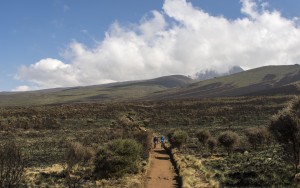 Some routes are longer than others by a few days. The longer the route the more time you will have to acclimatise.
Some routes are longer than others by a few days. The longer the route the more time you will have to acclimatise.
We were restrained by dates and had limited time so we opted for the 6 day Rongai route.
Personally if we hadn’t had date and time restrictions I would have chosen one of the longer routes such as Lemosho. The longer routes tend to be a little more expensive but you’ll be increasing your chances of getting to the top. You don’t want to not get to the top after spending so much money and telling everyone where you are going.
Having said that I was tired and looking forward to getting off the mountain after 6 days of no shower.
If you haven’t got that much time. We were told that Machame is best for acclimatisation as it is very up and down but is probably one of the hardest as a result. On the plus side it is one of the most scenic routes.
Marangu is one of the shortest, cheapest and most direct routes. In some ways the directness makes it easy, but in other ways it makes it more difficult, as it is steeper, and has less opportunities for acclimatisation. On the upside, you sleep in huts with beds, running toilets and even showers in some camps which is a lot more comfortable than camping.
Rongai had good opportunities for acclimatisation and can also be quite scenic. It’s also a little less steep than the others so it’s more gradual. The down side is the ascent via Gilmans Point.
3. Go with a Good Company
Everyone who climbs Kilimanjaro needs to go with a certified guide.
We booked through Exodus who outsourced their tour to the African Walking Company (AWC). Had we known this, we would have probably booked directly with AWC. However, as a result of booking through Exodus, we had a much smaller group. We had 6 people in total as opposed to 16 in the AWC group who were travelling along side us.
We were lucky in that every single person in our group got on and supported each other and kept eachother’s spirits up. It was like being in a cut down African version of Sound of Music sans the singing.
The larger AWC group had a few cliques and obnoxious blokes which seemed to get the rest of the group down. A third of the larger group didn’t make it. Half of the ones who did make it to the top were using bottled oxygen. 
I was really impressed by the service we got from AWC and wouldn’t hesitate to recommend them or Exodus. I subsequently met others who had walked up Kili with AWC too, and they also recommended them. AWC have a good reputation in terms of how they treat and pay their porters which I think is one of the reasons Exodus use them.
4. Prepare Yourself Physically
You have to be aerobically fit, although it’s hard to quantify what this means. If you can run/jog a few miles continuously then you should be in good shape aerobically.
If you’ve got good guides, most of the walking will be slow, but some guides walk fast – I struggled to keep up with one of ours. I also found that although we were going slow on summit day and frequently stopping, my heart was racing and my leg muscles were burning.
For your sake and the sake of your group you need to be able to deal with it.
Your legs have to be strong. The walk on summit night is extremely steep and the slopes will be busy, (it was literally packed when we did it). You’ll often be stopping and starting as a result.
They say the best training for Kili is lots of hill walking so do some training walks before hand.
In the UK, go climb Ben Nevis, Croagh Patrick, Snowdon and a few longer walks such as the Yorkshire Three Peaks, the Sca Fell and Scafell Pyke loop from Boot (in the same day) in the Lake District, or even the National Three Peaks Challenge. It’s a small investment compared to the cost of the rest of your Kili trip.
Summit night will take it out of you. It’s a slow walk but at altitude it will feel like you are going much faster. We started at around 11.30pm and didn’t stop walking until 5pm the next day…it’s an endurance challenge on little sleep.
Do a few long training walks on a couple of hours sleep and it will help you prepare for summit night! The key is to be able to push yourself to deal with what you think you can’t do.
5. Prepare Yourself Mentally
For me, climbing Kilimanjaro was more of a mental rather than physical challenge. I was nervous about the climb and worried that I wouldn’t make it. I had friends that had made it, and I didn’t want to be the one that failed, the one going home embarrassed with my tail between my legs!
On the flight from Nairobi to Kilimanjaro airport, we passed Mount Kilimanjaro and could see it clearly from our plane window. The plane was only flying at what looked like a height which was only about half way up the mountain. It completely freaked me out – the summit was above the clouds and way higher than the plane! The prospect of walking to the top of something that high seemed crazy!
Early on the second day, I was the first person to throw up in my group. We weren’t even at altitude yet! I felt pretty pathetic and am sure it was nerves that got to me.
After shaming myself in front of everyone however, I felt much better! Whenever I felt nauseous after that, I would imagine that I was walking up a mountain in the UK, and not at altitude. It helped calm my nerves and I didn’t thrown up again.
It’s imperative that you maintain a positive mental attitude throughout. Believe you can make it, and get used to dealing with physical discomfort for a few days.
Mentally prepare with how you are going to overcome feeling sick or tired. Don’t expect it to be easy.
Think about what aids you can take with you to keep your spirits up, this could be uplifting reading material or upbeat music on an ipod. (I don’t think I’d have been able to summit without my Playlist of Champions!).
6. Prepare for Going to the Toilet on Kilimanjaro
AWC carried a chemical toilet for us which was usually set up when we had lunch and when we camped. In between those stops you’re going to have to find a rock to hide behind.
I was pretty disgusted by the amount of toilet paper discarded on the mountain. Kili is a mountain not a toilet people! Take a nappy bag with you and put your toilet paper in that.
If you’re a bloke bear in mind what direction the wind is blowing in, we saw one guy urinate directly into the wind, only to have his urine blown all over himself!
Ladies, if you are a considering taking a she wee make sure you get the hang of it before you go. I didn’t really figure it out before I went, (despite a disastrous episode in the Lake District…) and basically wet myself on the mountain, (not what you want to do when you have to wear the same clothes for the next few days…). It was the afternoon after I had just thrown up on myself too, (I think from stress), so it wasn’t a great day!
7. Prepare to Deal with Altitude Sickness
Without testing your blood, it’s hard to know how your body will react at altitude. Even if you’ve been fine at altitude before, you can still get altitude sickness.
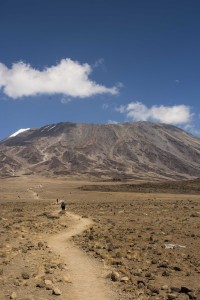 If possible, do some walks at altitude to see how your body reacts. There are plenty of high mountains in Europe that are easily accessible. You can even get a cable car or train up to the top of some like the Jungfrau in Switzerland (the station at the top is at 3,454m/11,342ft).
If possible, do some walks at altitude to see how your body reacts. There are plenty of high mountains in Europe that are easily accessible. You can even get a cable car or train up to the top of some like the Jungfrau in Switzerland (the station at the top is at 3,454m/11,342ft).
To get your body used to walking at altitude, you can also get to Africa a bit earlier and do some day walks at over 3,000m, or spend a couple of nights at the Ngorongoro Crater. Some of the lodges are on the crater rim at around 2,400m high.
To take Diamox or to not take Diamox?
Diamox is a prescription drug (in the UK at least), usually used for people with Glaucoma. I’m not sure how it works but it is also used for relieving the symptoms of altitude sickness.
Go see your travel doctor before you go to discuss whether or not you would like to take it or not. Your doctor may ask you do to do a 2 day trial using the drug to make sure that you do not experience any bad side effects before s/he prescribes it to you.
I was torn about whether we should take it or not. I have friends who have summitted while taking Diamox and some without.
Two people in our group were not taking Diamox and on summit day there was a massive difference between them and those who had been taking the drug. The ones who were not taking it, were really ill, looked dreadful and were really struggling to breathe on summit day. They almost didn’t make it. The rest of us were comparatively okay. I would recommend taking it. Again, do you want to spend all that money and time training only to fail?
My boyfriend had some mild headaches, on the summit day, for which he took Nurofen. I popped a few pain killers before we started walking up the summit and was lucky, I felt fine.
Diamox is supposed to make you pee more. Maybe I have inefficient kidneys, but personally I didn’t feel that it made that much difference to me unless I took it just before bed time. We were told to start taking it the day we started our trek and to take one tablet on waking up early in the morning and one around 4pm.
Diamox is also supposed to give you pins and needles in my fingers and toes but it usually disappeared after a few minutes. Some doctors told us that half a tablet worked just as well as a full one.
What happens if you get altitude sickness?
Altitude sickness can be extremely serious but is normal on the summit.
We were told that if any of us threw up, we would still be allowed to continue unless we were constantly vomiting or had crackly lungs. Having said that, there seemed to be lots of people throwing up and looking like death all over the place on the way to the summit, so I’m not sure how sick you have to be to be told that you need to go down.
I was shocked by the number of people walking to the summit who were propped up by porters and looked like they were going to die. Seriously, it was frightening! Clients would throw up, walk a few metres, throw up again, and continue the cycle until they reached the summit. It wasn’t a pretty sight but many still made it, miraculously.
A couple in our group did throw up a few times on summit night but they still made it and I have a massive amount of respect for them as a result. They must have felt terrible but still made it – a huge achievement.
Should you use bottled oxygen?
I was surprised to see so many people using oxygen tanks on the walk up to the summit of Kilimanjaro. These weren’t people who were given oxygen in an emergency, these were people who were routinely relying on oxygen for the summit, and had bought a few bottles as part of their tour.
The downside with oxygen is that it usually includes you testing it on an acclimatisation walk on the day prior to summit day. This will mean that your body will lose out on an opportunity to acclimatise naturally, and you might find the walk to the summit much harder than usual.
Having bottled oxygen does not guarantee that you will make it. Many in one of the groups were still turning back.
It’s also possible to run out of oxygen – if this happens, since your body won’t have had a chance to acclimatise, you might panic or feel compelled to turn back. Your guide may also make you return because of the increased altitude sickness risk.
The other disadvantage is that it looks like you’ve got some major medical issues with tubes sticking into their nostrils – it didn’t make for good summit photos and it didn’t look comfortable.
It’s also more expensive. As you’ll need to carry the oxygen tank on your back, you’ll also need to pay for a porter to accompany you on the walk up the summit who will also carry your day bag for you.
I can see why you would need extra oxygen on Everest, but personally I don’t think you should need it to get to the summit of Kilimanjaro. Still, it’s a personal issue so you need to do what’s right for you.
8. Wear the Right Clothes and Take the Right Gear
You can check out the full packing list for Kilimanjaro here.
In summary, the right gear will make your life easier on the walk up, as well as on summit night. It’s worth investing or borrowing good quality gear.
Summit night is cold, but you will still be working out and sweating lots. Warm breathable layers are best.
I was wearing a thermal top, a t-shirt, a fleece, a soft shell and a down jacket on summit night and had to stop after a while to take some layers off – I took my soft shell and could probably have taken off my fleece as well.
I would get cold when we stopped but would get very hot after walking for a few minutes, at which point I would start feeling nauseous and would have to start unzipping all my layers to try and cool down.
9. Take it Easy, Pace Yourself and Look after Yourself
This was the best advice I was given. Take it all one step at the time. Don’t think about the summit. Just concentrate on putting one foot in front of the other.
Friends of mind who had successfully climbed Kili before told us that the people in their group who had really struggled were those who had gone fast at the beginning. Sometimes these were even the fittest people in their group. Spearheading the front of the group only to be a mess or fail on summit day won’t do your ego any favours. Take it easy, it’s not race.
Coincidentally, it was the two guys who had been at the front walking ahead of the guide for the first few days were also the ones struggling towards summit day, although to be fair, they were also the only ones not taking Diamox too.
Walking up to the top of Kili is long and arduous. Conserve your energy as much as possible on the way up to the summit, by walking slowly, resting and sleeping as much as you can.
Eating is important. Many in our group lost their appetite and didn’t eat much on the run up to the summit which was understandable, but your body needs food as energy.
I forced myself to eat and am glad I did. On summit night your body might have a 16 hour gap between any proper meals, so make sure you load up your body properly beforehand, and take some snacks in case you feel like eating them on the way up or down.
What is Summiting Kili like?
Expect it to be busy. There’ll be a queue for you to have your photo by the sign and your guide will be keen to get you off the mountain ASAP.
Your guide will want to start getting more oxygen into you and you will probably have another 8-10 hours of walking ahead of you….
Having said that some people brought flags, whisky, engagement rings and even wedding rings for divorcees to throw away at the top. We had the option of ordering a bottle of champagne to crack open at the summit for $30.
For me, and others in my group, it was a pretty emotional experience. We had spent months training and preparing for the climb, and a few of us, myself included even doubted whether we would make it at times.
The way down from Uhuru is long. Not only do you have to get back to your base camp but you usually have to walk to the next camp too. It’s a very long day.
Think Ahead About Finishing the Climb
Make sure you have at least one set of clean clothes in the bag which you leave in your hotel.
You and your clothes are going to be disgustingly filthy when you get back to your hotel. I had to wash my hair 4 times before dust stopped flowing out of it…
Should you stay in Tanzania after the climb?
Stay. Lots of people fly in, climb Kili, then leave the day after. It’s a long way to go to do just that. If you’ve got the time, arrive a few days earlier to let your body get over the jet lag and acclimatise a little. Maybe visit a high altitude safari park like Ngorongoro if you can afford it.
Afterwards, fly to Zanzibar for a few days of well deserved relaxation before heading home or to your next destination.
Walking up Kilimanjaro is one of the most expensive things we’ve done. It was also one of the best and most rewarding. Physically and mentally it was a good challenge and we were lucky to have met some great people doing it. I would recommend it, just make sure you look into it properly, go at a decent time of year, with a good company, prepare yourself and you will be fine.
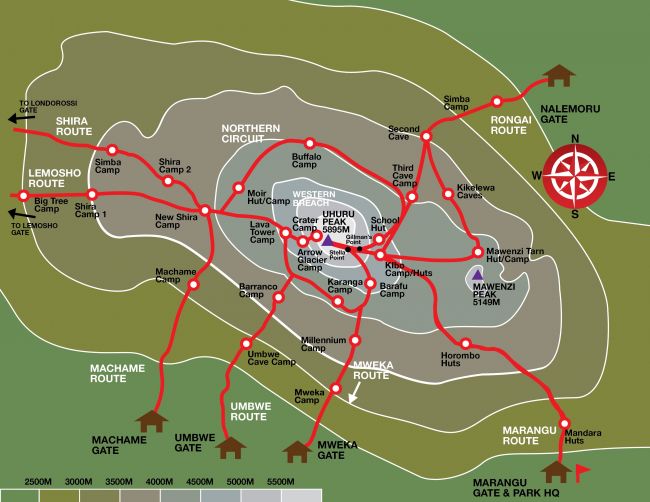
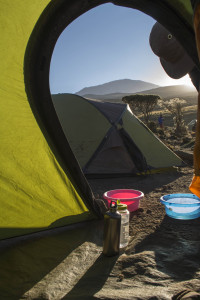
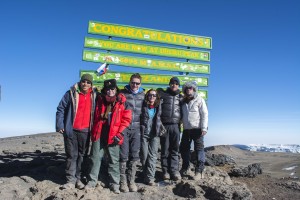
One thought on “How to Get to the Top of Kilimanjaro”
Comments are closed.